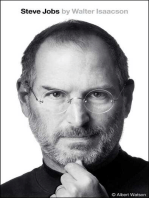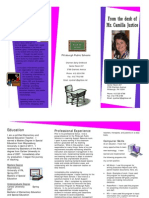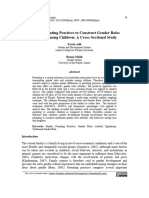0 ratings0% found this document useful (0 votes)
36 viewsAn Overview of Human Behavior in Organizations
An Overview of Human Behavior in Organizations
Uploaded by
Cris Tine1. Organizational behavior is the study of human behavior in organizations and how individuals interact within an organization. It aims to explain, predict, understand, and control behavior.
2. Early contributors to OB include Frederick Taylor with his scientific management approach, and Elton Mayo who conducted the Hawthorne studies and concluded that social interaction impacts productivity.
3. Individuals differ in important ways like productivity, commitment, and reaction to leadership. Accounting for these differences is important for an organization's effectiveness.
Copyright:
© All Rights Reserved
Available Formats
Download as DOCX, PDF, TXT or read online from Scribd
An Overview of Human Behavior in Organizations
An Overview of Human Behavior in Organizations
Uploaded by
Cris Tine0 ratings0% found this document useful (0 votes)
36 views8 pages1. Organizational behavior is the study of human behavior in organizations and how individuals interact within an organization. It aims to explain, predict, understand, and control behavior.
2. Early contributors to OB include Frederick Taylor with his scientific management approach, and Elton Mayo who conducted the Hawthorne studies and concluded that social interaction impacts productivity.
3. Individuals differ in important ways like productivity, commitment, and reaction to leadership. Accounting for these differences is important for an organization's effectiveness.
Original Title
hbo
Copyright
© © All Rights Reserved
Available Formats
DOCX, PDF, TXT or read online from Scribd
Share this document
Did you find this document useful?
Is this content inappropriate?
1. Organizational behavior is the study of human behavior in organizations and how individuals interact within an organization. It aims to explain, predict, understand, and control behavior.
2. Early contributors to OB include Frederick Taylor with his scientific management approach, and Elton Mayo who conducted the Hawthorne studies and concluded that social interaction impacts productivity.
3. Individuals differ in important ways like productivity, commitment, and reaction to leadership. Accounting for these differences is important for an organization's effectiveness.
Copyright:
© All Rights Reserved
Available Formats
Download as DOCX, PDF, TXT or read online from Scribd
Download as docx, pdf, or txt
0 ratings0% found this document useful (0 votes)
36 views8 pagesAn Overview of Human Behavior in Organizations
An Overview of Human Behavior in Organizations
Uploaded by
Cris Tine1. Organizational behavior is the study of human behavior in organizations and how individuals interact within an organization. It aims to explain, predict, understand, and control behavior.
2. Early contributors to OB include Frederick Taylor with his scientific management approach, and Elton Mayo who conducted the Hawthorne studies and concluded that social interaction impacts productivity.
3. Individuals differ in important ways like productivity, commitment, and reaction to leadership. Accounting for these differences is important for an organization's effectiveness.
Copyright:
© All Rights Reserved
Available Formats
Download as DOCX, PDF, TXT or read online from Scribd
Download as docx, pdf, or txt
You are on page 1of 8
Chapter 1 ✔ Personal growth makes a person highly
An Overview of Human Behavior in Organizations competitive in the workplace. The chance to
Human Behavior achieve personal growth is enhanced by
⮚ Human behavior refers to the physical actions of knowledge of OB.
a person that can be seen or heard such as 3. Enhancement of Organizational and Individual
smiling or whistling. Effectiveness
Organizational Behavior ✔ Effectiveness is a major attribute of successful
⮚ Organizational behavior or OB may be defined as organizations, as well as individuals.
the study of human behavior in organization, of Efficiency- doing things right output↑ input↓
the interaction between individuals and the Effectiveness- doing the right thing
organization and of the organization itself. 4. Sharpening and Refinement of Common Sense
The Goals of OB ✔ People differ in the degree of common sense
⮚ The three goals of OB are as follows: they possess.
1. to explain behavior- describe systematically Brief History of Organizational Behavior
2. to predict behavior - forecasting ⮚ The origins of OB can be traced to the following:
3. to understand behavior- understand reasons of 1. The human relations approach
reaction of employees, why people behave a. The scientific management approach by
4. to control behavior- power for develop Frederick W. Taylor
The Elements of OB. Forces affecting OB ✔ Frederick Taylor was the well-known disciple of
1. People the scientific management movement.
✔ The internal social system of the organization ✔ Taylor used scientific analysis and experiment to
is composed of people consisting of individual increase worker output. He did it by regarding
persons and groups. individuals as equivalents of machine parts and
HR – most important asset assigned them specific repetitive tasks.
2. Structure b. The human relations approach by Elton
✔ The structure defines the formal Mayo and others
relationship of people in the organization. ✔ Elton Mayo and his research team conducted the
Papaano gagamitin angmga tao Hawthorne studies in 1920 to determine what
3. Technology effect hours of work, periods of rests and lighting
✔ It refers to the combination of resources, might have on worker fatigue and productivity.
knowledge and techniques with which o Mayo concluded that social interaction is
people work and affect the task that they a factor for increased productivity.
perform. 2. The personality approach
4. Environment a. Freud’s model
✔ It refers to the institutions or forces outside ✔ Sigmund Freud brought the idea that people are
the organization that potentially affect the motivated by far more than conscious logical
organization’s performance. reasoning.
Internal-controllable PVMO_ PHILOSOPHY b. The humanist approach by Carl Rogers,
VULISION MISSION OBJECTIVES Abraham Maslow
EXTERNAL- uncontrollable ✔ Rogers focused on the person as an
individual instead of adhering to a rigid
The Benefits of Studying Organizational Behavior methodology.
1. Development of People Skills He believes that people should acquire their own values
✔ There are two types of skills that a person will and attitudes rather than be committed to a fixed set of
need to succeed in his chosen career: prescribed goals.
a. The skill in doing his work ✔ Abraham Maslow forwarded his model
b. The skill in relating with people which espouses the idea of developing the
2. Personal Growth personality toward the ultimate achievement
of human potential.
o This process is referred to as self-actualization. to manufacture. If this process of handling
o To achieve this objective, the person must work his way materials can be applied to the management of
up the succeeding steps of a hierarchy of needs. people, achieving the objectives of the
Heirarchy of needs organization will be a much easier task. This
Physiological-basic needs cannot happen because of the big difference
Safety and securit- between materials and people.
Love and belongingness ● Materials do not complain even if they are cut
Self esteem into standardized pieces, or stored in a
Self actualization warehouse. People cannot be subjected to such
What is Ethics what is right and wrong treatment if they are to be useful to the
⮚ Ethics refers to the set of moral choices a person organization:
makes based on what he or she ought to do. INDIVIDUAL DIFFERENCES
⮚ Organizational ethics are moral principles that ● Individual differences refer to the variation in how
define right or wrong behavior in organizations. people respond to the same situation based on
⮚ Ethical behavior refers to behavior that is personal characteristics. ‘The idea is that each
accepted as morally good and right as opposed to person is different from all others and that these
bad and wrong. differences are usually substantial rather than
⮚ What constitutes right and wrong behavior in meaningless.
organization is determined by: Consequences of Individual Differences
a. the public ● Individual differences become serious concerns
b. interest groups when people are situated in the workplace. Those
c. organizations concerned with managing people or simply those
d. the individual’s personal morals that want to relate well with people must be
and values. aware that there are consequences arising out of
Ethical Issues differences between people. These pertain to the
⮚ There are important ethical issues that following:
confront organizations. They consist of the 1. people differ in productivity;
following: 2. people differ in the quality of their work;
a. Conflict of interest 3. people react differently to empowerment;
✔ It exists when a person is in the position of 4. people react differently to any style of
having to decide whether to advance the leadership;
interests of the organization or operate in his or 5. people differ in terms of need for contact with
her own personal interests. other people;
b. Fairness and honesty 6. people differ in terms of commitment to the
✔ In organizations which practices ethical organization; and
behavior, people do not accept bribes to 7. people differ in terms of level of self-esteem.
influence the outcome of a decision. ● Productivity refers to the rate of output per
c. Communication worker. It differs from person to person.
✔ People can become victims of organizations ● Empowerment means giving someone the power
that provide false and misleading information to do. Something.
about their products and services. ● If all subordinates in a given unit will respond well
d. Relationships within the organization to a single style of leadership, managing them or
✔ Within the organization, people may still be simply relating with them would be a much easier
performing unethical acts. task. But this is not so, as some people will prefer
Chapter 2 a leáder with a democratic style, while some will
INDIVIDUAL DIFFERENCES,MENTAL ABILITY, AND need close supervision from their superiors. These
PERSONALITY differences make it necessary for a leader to use
● Workers in most factories produce standardized different leadership styles even in a small unit.
materials that will make the final product easier
● Regarding the need for sociaI contact, people are 1.problem solving abilities;
also different from one another. Some will need 2.analytical skills;
more contact; while others can work alone the 3.competitive drive;
whole day. Other people cannot be productive 4.motivation;
unless they meet people as they work. The 5.learning ability;and
salesman’s job, for instance, is well fitted for 6.sociability
those in neèd of frequent interactions with other Generational and Age-Based Differences.
people. In contrast, there are those who can ● A worker that belongs to a certain generation may
perform jobs in research laboratories where behave differently from a worker who belongs to
contact with others is minimal. another. This difference look is called generational
● Commitment to the organization varies among difference. An example may be derived from the
individuals. Some are so committed and loyal to changes in values over generations. For instance,
the organization that they work the whole day in a generation that values loyalty, it will not be
without noticing that they are putting in more difficult to find workers who have stayed in their
than the required working hours. Those who are respective companies for long periods. The
highly committed to the organization tend to opposite may be expected from a generation that
produce high quality output, while those who are values something else.
less committed are less concerned about output ● Differences in the ages of workers also bring
and attendance. about expectations of differences in the behavior
● People also differ in terms of self-esteem. Those of workers. Most often, age is associated with
with low self-esteem tend to be less productive. experience, so we take it as a matter of course
They also avoid accepting more responsibilities. when a 61 year old person says tat he has 40
They do so for various reasons, one of which is years of teaching experience, or when a 26 year
that they may think that their abilities do not old employee has a 5 year teaching experience.
match the requirements of the job. The opposite This is not always true,however,because there are
happens when people have high regard of instances when people over 60 years old have less
themselves. Many great inventions, literary work, than 10 years of teaching experience. In general,
and discoveries were made by people with high however, we consider age and experiences as
self-esteem. related.
WHAT MAKES PEOPLE DIFFERENT FROM EACH Culture.
OTHER ● Differences in job performance and behavior
People are different from each other because they are are sometimes caused by differences in
different in terms of the following: culture.
1.demographics; ● Culture refers to the learned and shared ways
2. aptitude and ability; and of thinking and acting among a group of
3. personality. people or society. This definition implies that
Demographic Diversity culture has two dimensions. Specifically, these
The sources of demographic diversity include the are classified as follows:
following: 1. Social culture – which refers to the social
1. gender; environment of human-created beliefs, customs,
2. generational differences and age; and knowledge, and practices that define conventional
3.culture. behavior in a society.
Gender Differences 2.·Organizational culture- is the set of values, beliefs,
● The differences in the perception of male and and norms that is shared among members of an
female roles are referred to as gender differences. organization.
Research findings indicate that there are very few Aptitude and Ability
differences between men and women that affect ● People differ in terms of aptitude and ability and
job performance. Specifically, men and women their behavior in the organization is affected.
are not different along the following concerns:
● Aptitude may be defined as the capacity of a Intellectual abilities refer to the capacity to
person to learn or acquire skills: Ability refers to do mental activities, such as thinking,
an individual’s capacity to perform the various reasoning, and problem solving.
tasks in a job. Dimensions of Intellectual Ability
● Aptitudes and abilities are very important Intelligence is composed of four subparts
considerations when people are considered for which are as follows:
employment in an organization. The managers of 1. cognitive
business firms will be much concerned with the 2. social
training new employees before they become 3. emotional
productive. Low aptitude and abilities would 4. cultural
mean higher training costs. Cognitive intelligence refers to the capacity of a
person to acquire and apply knowledge including
● A person's overall abilities are made up of two solving problems.
sets of factors: physical and mental. Social intelligence refers to a person’s ability to relate
effectively with others.
● Physical ability refers to the capacity of the Emotional intelligence refers to a person’s qualities
individual to do tasks demanding stamina, such as understanding one’s own feelings, empathy
dexterity, strength, and similar characteristics. for others, and the regulation of emotion to enhance
Specifically, there are nine physical abilities living.
needed to perform certain tasks. These are the Cultural intelligence refers to an outsider’s
following: ability to interpret someone’s unfamiliar and
1. Dynamic strength - this is the ability to exert ambiguous behavior the same way that
muscular force repeatedly or continuously over time. person’s compatriot would.
2. Trunk strength - this is the ability to exert muscular The Triarchic Theory of Intelligence
strength using the trunk (particularly the abdominal ● An eminentresearcher, Robert
muscles) muscles. Sternberg,developed an approach to the study of
3. 'Static strength - this is the ability to exert intelligence, which is now known as the triarchic
force against external objects. theory of intelligence. He maintains that there
4. Explosive strength - this is the ability to are.three important parts of intelligence, namely:
expend a maximum of energy in one or a series of 1. componential intelligence;
explosive acts. 2. experiential intelligence; and
5. Extent flexibility-this is the ability to move the trunk 3. contextual intelligence.
and back muscles as far as possible. ● People can be good at any or all of the three
6. Dynamic flexibility - this is the ability to make intelligence parts.
rapid, repeated flexing movements. ● Componential intelligence, also referred to as
7.Body coordination - this is the ability to coordinate analytical intelligence, it involves components (or
the simultaneous actions of different parts of the mental processes) used in thinking. -
body. metacognitive
8. Balance-this is the ability to maintain equilibrium ● Experiential intelligence, also referred to as
despite forces pulling off balance. creative intelligence, is that type of intelligence
9. Stamina - this is the ability to continue that focuses on how people perform on tasks with
maximum effort requiring prolonged effort over time. which they have either little or no previous
● Individuals will differ as to the extent by which experience or else great experience.
they can perform any of the above-cited physical ● Contextual intelligence, also known as practical
abilities. intelligence, is a type of everyday intelligence or
● The intellectual or mental ability of a person (also street smarts. It requires adapting to, selecting,
referred to as intelligence) is one of the major and shaping our real-world environment.
sources of individual differences.
Multiple Intelligences
Another eminent researcher, Howard ● Personality refers to the sum total of ways in
Gardner, developed a very useful means of which an individual reacts and interacts with
understanding intelligence. It is referred to as others. The “ways” are the patterns of behavior
the Theory of Multiple Intelligences. He that are consistent and enduring.
proposes eight different components of Determinants of Personality
intelligence which the individual possesses in The personality of an individual is a result of both
varying degrees. hereditary and environmental factors. Heredity
A brief description of the components is provided as defines the limits by which an environment can
follows: develop personality characteristics.
1.Linguistic.Peoplewhopossess this component of Hereditary factors are those factors that are
intelligence is sensitive to language, meanings, and determined at conception.
the relations among words. Linguistic intelligence These include the following:
makes people able to communicate through language 1. physical stature
including reading, writing, and speaking. 2. facial attractiveness
2.Logical-Mathematical.This intelligence component 3. gender
covers abstract thought, precision, counting, 4. temperament
organization, and logical structure, enabling the 5. muscle composition and reflexes
individual to see relationship between objects and 6. energy level
solve problems such as those in algebra and actuarial 7. biological rhythms
concerns. Environmental factors are those that exert pressures
3. Musical. This intelligence component gives people on the formation of an individual’s personality. It
the capacity to create and understand meanings includes the following:
made out of sounds and to enjoy different types of 1. Cultural factor – which refer to the established
music. norms, attitudes, and values that are passed along
4. Spatial. This intelligence component enables from one generation to the next and creates
people to perceive and manipulate images in their consistency over time.
brain and to re-create them from memory, such as in 2. Social factor-which refer to those that reflect family
making graphic designs. life, religion and the many kinds of formal and
5. Bodily-kinesthetic. This intelligence enables people informal groups in which the individual participates
to use their body and perceptual and motor systems throughout his life.
in skilled ways, such as dancing, playing sports, and 3. Situational factors-which indicate that the
expressing emotion through facial expressions. individual will behave differently in different
6. Intrapersonal. The person with this kind’ of situations. For instance, a teenager will be less
intelligence has highly accurate understanding of talkative when in the presence of strangers. He will be
himself or herself. He or she is sensitive to his or her more relaxed, however, when he is among friends and
values, purpose, feelings, and has a developed sense relatives.
of self. Personality Factors and Traits
7. Interpersonal. This intelligence component makes ● There are certain factors that are considered in
it possible for persons to recognize and make determining human personality. A person’s
distinctions among the feelings, motives, and personality traits could either be on the positive
intentions of others, as in managing people and or negative side of the factors, and they will be in
parenting children. various degrees of development. It is not hard to
8. Naturalist. A person with this intelligence possesses think that two or more persons will have the same
the ability to seek patterns in the external physical traits that are developed in different degrees. This
environment. As a result, the opportunity to enrich all alone provides sufficient indication that
the other seven intelligences is provided. individuals are really different from one another.
The eight factors are briefly described below:
Personality 1. Emotional stability. This personality. Factor
characterize one as calm, self-confident, and
secure. Its opposite is emotional instability The five components of EQ are the following:
characterized by nervousness, depression, and 1. Self-regulation. This refers to the ability to
insecurity. calm down anxiety, control impulsiveness, and react
2. Extraversion. This is the personality factor appropriately to anger.
describing someone who is sociable, gregarious, and 2. Motivation. This refers to the passion to work for
assertive. The opposite is introversion, which reasons that go beyond money or status.
describes a person who tends to be reserved, timid, 3. Empathy. This refers to the ability to respond to the
and quiet. unspoken feelings of others.
3. Openness to experience. This is a personality factor 4. Self-awareness. This refers to the awareness of
describing a person who is imaginative, cultured, one’s own personality or individuality.
curious, original, broad-minded, intelligent, and 5. Social skills. This refers to the proficiency to
artistically sensitive. The opposite is the person who is manage relationships and building networks.
conventional and finds comfort in the familiar. MORE ON PHYSICAL ABILITY
4. Agreeableness. This factor refers to the person’s ● Most writers of OB limit their discussion of
interpersonal orientation. An agreeable person is physical ability on traits like stamina, dexterity,
cooperative, warm, and trusting. The person who is and strength. They failed to mention other
not agreeable is cold, disagreeable, and antagonistic. aspects that make individuals different from each
5. Conscientiousness. This factor refers to a person’s other.
reliability. Those with a high degree of ● This writer feels that the following factors are
conscientiousness are responsible, organized, important in determining the reasons for
dependable, and persistent. Those with a low degree differences in individual behavior:
of conscientiousness are easily distracted, 1. Sense of sight. People differ in what they actually
disorganized, and unreliable. see. For instance, some persons are color blind.
6. Self-monitoring behavior. This reflects a person’s Clearly, these persons will find it difficult to perform
ability to adjust his or her behavior to external, jobs that require the ability to distinguish colors.
situational or environmental factors. High self 2. Sense of hearing. People differ in their ability to
monitors are pragmatic and are capable of putting on hear. Some people may not be able to distinguish one
different faces for different audiences. Low self- tone from another. This alone makes them different
monitors find it hard to act or behave as the situation from other people in terms of hearing ability. Those
requires. considered tone deaf would not be able to perform as
7. Risk taking and thrill seeking. These refers to the singers, musicians, conductors, recording engineers,
person’s willingness to take risk and pursue thrills that and the like.
sometimes are required in the workplaces. Some jobs 3. Sense of taste. A person’s tongue may be sensitive
like those of movie stunts are dangerous and will to various tastes and this makes him or her different
require a high degree of risk taking and thrill seeking from another person who is less sensitive to taste.
sense. The degrees of taste sensitivity vary from person to
8. Optimism. This refers to the tendency to experience person.
positive emotional states and to typically believe that 4. Sense of smell. People have different degrees of
positive outcomes will be forthcoming from most sensitivity to smell. Those with excellent sense of
activities. This is the opposite of pessimism which is smell would fit in jobs related to the manufacture of
the tendency to experience negative emotional states perfume, soap, food, and some others.
and to typically believe that negative outcomes will be 5. Sense of touch. A person’s sense of touch may
forthcoming from most activities. differ in degree with another person’s. As such, their
EMOTIONAL INTELLIGENCE behavior will differ when confronted with similar
● The concept of emotional intelligence or situations. For instance, when five persons are
emotional quotient (EQ) was introduced by Daniel blindfolded, and they are requested to touch an
Goleman. EQ refers to the ability of the person to object, some of them may be able to identify correctly
accurately perceive, evaluate, express and the object and some will not.
regulate emotions and feelings.
PERCEPTION
Chapter 3 Perception may be defined as the process by which
LEARNING,PERCEPTION,AND ATTRIBUTION people select, organize, interpret, retrieve, and
LEARNING respond to information from their environment.
● Acquiring a complex set of sophisticated skills Factors Influencing Perception
is a result of change that comes from learning. Perception is influenced by the characteristics of the
An understanding of how people learn is very following:
important because it will help people explain 1. the perceiver
and predict behavior. 2. the target
What is Learning 3. the situation
Learning may be defined as a relatively permanent The Perceiver
change in behavior or knowledge due to experience. ● The person who perceives the target is the
When a person behaves differently from what he perceiver.
previously did, it can be said that there is change in The Target
the person’s behavior. With change there is learning. ● The person, object, or event that is perceived
A change in behavior happens due to any or both of by another person is the target. Perception
the following: may be modified by the following factors
1. Learning; or which are typical characteristics of targets:
2. Other causes such as drugs, injury, disease and 1. contrast
maturation. 2. intensity
3. figure-ground separation
THEORIES OF LEARNING 4. size
Eminent researchers have developed theories that 5. motion
help explain the learning process. These theories 6. repetition or novelty
consist of classical conditioning, operant
conditioning, and social learning. The Situation
Classical Conditioning ● Perception is also affected by the surrounding
Classical conditioning may be defined as a type of environment.
learning in which a stimulus acquires the capacity to ● The situational factors that affect perception
evoke a response that was originally evoked by are: time, work setting, and social setting.
another stimulus. A stimulus is something that incites
action. ATTRIBUTION
Operant Conditioning ● There are other theories that may be useful
Operant conditioning may be defined as a type of for a better understanding of human
learning where people learn to repeat behaviors that behavior. One of these refers to attribution.
bring them pleasurable outcomes and to avoid ● Attribution theory is the process by which
behaviors that lead to uncomfortable outcomes. people ascribe causes to the behavior they
Social Learning perceive. An example is provided as follows:
Social learning may be defined as the process of Common Attribution Errors
observing the behavior of others, recognizing its ● When people make attempts to determine the
consequences, and altering behavior as a result. One causes of other people’s behavior, errors
of the ways by which people learn is through social commonly happen. These errors may be classified
contacts with other people. into the following types:
How Social Learning is Achieved 1. the fundamental attribution errors, and
Social learning may be done in three ways namely: 2. the self-serving bias
1: by observing what happens to other people; The fundamental attribution errors refer to the
2. by being told about something; and tendency to underestimate the influence of external
3. through direct experience. factors and overestimate the influence of internal or
personal factors in the behavior of others.
The self-serving bias is that type of attribution error ● Contrasting situations, oftentimes, lead to
whereby people tend to attribute their achievements inaccurate evaluation of a person’s character
to their good inner qualities, whereas they attribute and ability.
their failures to adverse factors within the Projectlon
environment. ● Projection is attributing one’s own thoughts,
Factors That Influence Attribution feelings, or motives to another. It is likely to
When people try to determine the cause of a person’s occur in the interpretation stage of
behavior, i.e. Whether the cause is internal or perception.
external, some factors influence such effort. The Stereotyping
factors refer to the following: ● Stereotyping refers to judging someone on
1. distinctiveness the basis of one’s perception of the group to
2. consensus which that person belongs.
3. consistency
Distinctiveness
● The consideration given to how consistent a
person’s behavior is across different situations is
referred to as distinctiveness.
Consensus
● This refers to the likelihood that all those facing
the same situation will have similar responses.
Consistency
● This refers to the measure of whether an
individual responds the same way across time.
SHORTCUTS USED IN FORMING IMPRESSIONS OF
OTHERS
The shortcuts refer to the following:
1. selective perception
2. halo effect
3. contrast effects
4. projection
5. stereotyping
Selective Perception
● Selective perception happens when a person
selectively interprets what he sees on the basis of
his interests, background, experience, and
attitudes.
Halo Effect
● Halo effect occurs when one attribute of a person
or situation is used to develop an overall
impression of the person or situation.’ For
instance, a brilliant criminal lawyer may also be
perceived by many to be also brilliant when he
engage in selling real estate.
● “Halo” refers to that ring of light just above the
head of a saint as we see it in pictures or
paintings. The “halo” signifies that everything
about the saint is holy.
Contrast Effects
You might also like
- The Subtle Art of Not Giving a F*ck: A Counterintuitive Approach to Living a Good LifeFrom EverandThe Subtle Art of Not Giving a F*ck: A Counterintuitive Approach to Living a Good LifeRating: 4 out of 5 stars4/5 (6026)
- The Gifts of Imperfection: Let Go of Who You Think You're Supposed to Be and Embrace Who You AreFrom EverandThe Gifts of Imperfection: Let Go of Who You Think You're Supposed to Be and Embrace Who You AreRating: 4 out of 5 stars4/5 (1133)
- Never Split the Difference: Negotiating As If Your Life Depended On ItFrom EverandNever Split the Difference: Negotiating As If Your Life Depended On ItRating: 4.5 out of 5 stars4.5/5 (911)
- Grit: The Power of Passion and PerseveranceFrom EverandGrit: The Power of Passion and PerseveranceRating: 4 out of 5 stars4/5 (628)
- Hidden Figures: The American Dream and the Untold Story of the Black Women Mathematicians Who Helped Win the Space RaceFrom EverandHidden Figures: The American Dream and the Untold Story of the Black Women Mathematicians Who Helped Win the Space RaceRating: 4 out of 5 stars4/5 (938)
- Shoe Dog: A Memoir by the Creator of NikeFrom EverandShoe Dog: A Memoir by the Creator of NikeRating: 4.5 out of 5 stars4.5/5 (548)
- The Hard Thing About Hard Things: Building a Business When There Are No Easy AnswersFrom EverandThe Hard Thing About Hard Things: Building a Business When There Are No Easy AnswersRating: 4.5 out of 5 stars4.5/5 (359)
- Her Body and Other Parties: StoriesFrom EverandHer Body and Other Parties: StoriesRating: 4 out of 5 stars4/5 (831)
- Elon Musk: Tesla, SpaceX, and the Quest for a Fantastic FutureFrom EverandElon Musk: Tesla, SpaceX, and the Quest for a Fantastic FutureRating: 4.5 out of 5 stars4.5/5 (481)
- The Emperor of All Maladies: A Biography of CancerFrom EverandThe Emperor of All Maladies: A Biography of CancerRating: 4.5 out of 5 stars4.5/5 (275)
- The Little Book of Hygge: Danish Secrets to Happy LivingFrom EverandThe Little Book of Hygge: Danish Secrets to Happy LivingRating: 3.5 out of 5 stars3.5/5 (434)
- The Yellow House: A Memoir (2019 National Book Award Winner)From EverandThe Yellow House: A Memoir (2019 National Book Award Winner)Rating: 4 out of 5 stars4/5 (99)
- Devil in the Grove: Thurgood Marshall, the Groveland Boys, and the Dawn of a New AmericaFrom EverandDevil in the Grove: Thurgood Marshall, the Groveland Boys, and the Dawn of a New AmericaRating: 4.5 out of 5 stars4.5/5 (273)
- The World Is Flat 3.0: A Brief History of the Twenty-first CenturyFrom EverandThe World Is Flat 3.0: A Brief History of the Twenty-first CenturyRating: 3.5 out of 5 stars3.5/5 (2283)
- The Sympathizer: A Novel (Pulitzer Prize for Fiction)From EverandThe Sympathizer: A Novel (Pulitzer Prize for Fiction)Rating: 4.5 out of 5 stars4.5/5 (125)
- A Heartbreaking Work Of Staggering Genius: A Memoir Based on a True StoryFrom EverandA Heartbreaking Work Of Staggering Genius: A Memoir Based on a True StoryRating: 3.5 out of 5 stars3.5/5 (233)
- Team of Rivals: The Political Genius of Abraham LincolnFrom EverandTeam of Rivals: The Political Genius of Abraham LincolnRating: 4.5 out of 5 stars4.5/5 (235)
- RCC 3.6Document17 pagesRCC 3.6Hayley Rose100% (1)
- On Fire: The (Burning) Case for a Green New DealFrom EverandOn Fire: The (Burning) Case for a Green New DealRating: 4 out of 5 stars4/5 (75)
- Introduction To Psychology TextDocument409 pagesIntroduction To Psychology TextYoshitha Jayamaha100% (14)
- The Unwinding: An Inner History of the New AmericaFrom EverandThe Unwinding: An Inner History of the New AmericaRating: 4 out of 5 stars4/5 (45)
- Zhang & Griffin, 2007Document6 pagesZhang & Griffin, 2007Leh LimaNo ratings yet
- Time and Stress Management Mr. Adedia DivneDocument37 pagesTime and Stress Management Mr. Adedia DivneDivine AdediaNo ratings yet
- Development of Emotional Intelligence in Pre-Service Teachers' To Increase Professional Well-BeingDocument3 pagesDevelopment of Emotional Intelligence in Pre-Service Teachers' To Increase Professional Well-BeingSValente100% (1)
- Conflict ManagementDocument3 pagesConflict Managementthebhas19540% (1)
- Camilla Justice BrochureDocument2 pagesCamilla Justice Brochurecjustice1No ratings yet
- Group DynamicsDocument32 pagesGroup DynamicsReshma RinuNo ratings yet
- Lesson Plan Outline: Kristen DavisonDocument4 pagesLesson Plan Outline: Kristen Davisonapi-338530955No ratings yet
- Studying While Anxious: Mathematics Anxiety and The Avoidance of Solving Practice Problems During Exam Preparation in College CalculusDocument11 pagesStudying While Anxious: Mathematics Anxiety and The Avoidance of Solving Practice Problems During Exam Preparation in College CalculusInes DuarteNo ratings yet
- Education in Human ValuesDocument7 pagesEducation in Human ValuesJeverlyn Luder0% (1)
- Review of Related Literature and StudiesDocument2 pagesReview of Related Literature and StudiesStracy100% (2)
- 200 Items PRof EdDocument18 pages200 Items PRof EdJoong SeoNo ratings yet
- Role of Parenting Practices To Construct Gender Roles Attitude Among Children A Cross Sectional StudyDocument15 pagesRole of Parenting Practices To Construct Gender Roles Attitude Among Children A Cross Sectional StudySair Abdulrehman ButtNo ratings yet
- Top 10 Leadership Qualities That Make Good LeadersDocument5 pagesTop 10 Leadership Qualities That Make Good LeadersNabi Ur RehmanNo ratings yet
- Bishnupriya College of Education (B.Ed.) : Name: Susmita SahaDocument12 pagesBishnupriya College of Education (B.Ed.) : Name: Susmita SahaPritam dasNo ratings yet
- 1-Managerial Communication IntroDocument36 pages1-Managerial Communication Introsushil_bhattara6864No ratings yet
- Mindsets and Brainology: Self-Theories of Intelligence and An InterventionDocument37 pagesMindsets and Brainology: Self-Theories of Intelligence and An InterventionKathy BoehmNo ratings yet
- A Decision-Making Perspective To Negotiation: A Review of The Past and A Look Into The FutureDocument3 pagesA Decision-Making Perspective To Negotiation: A Review of The Past and A Look Into The FutureAle PeredoNo ratings yet
- Tle 7 - W1 - Q1Document3 pagesTle 7 - W1 - Q1Rosette CapillasNo ratings yet
- Unit 9 AssignmentDocument3 pagesUnit 9 Assignmentapi-273337508No ratings yet
- The Use of Systematic Desensitization in Psychotherapy: (A) Trigeminal Neuralgia (B) Glossopharyngeal NeuralgiaDocument4 pagesThe Use of Systematic Desensitization in Psychotherapy: (A) Trigeminal Neuralgia (B) Glossopharyngeal NeuralgiaRaluca ElenaNo ratings yet
- LAS Practical Research 1 8Document2 pagesLAS Practical Research 1 8Oliver100% (1)
- 345Document1 page345winsonia94No ratings yet
- PE10 Q3 LAS 6 - Che Jalgalado - BNHSDocument6 pagesPE10 Q3 LAS 6 - Che Jalgalado - BNHSAna Donna Bongalos RacelisNo ratings yet
- Establishing Operations: Implications For The Assessment, Treatment, and Prevention of Problem BehaviorDocument26 pagesEstablishing Operations: Implications For The Assessment, Treatment, and Prevention of Problem BehaviorIulia Octavia MukbelNo ratings yet
- Jade Coetzer PRO 452 Lesson Plan 5Document5 pagesJade Coetzer PRO 452 Lesson Plan 5Jade CoetzerNo ratings yet
- Defining Normality and AbnormalityDocument35 pagesDefining Normality and AbnormalityDemi Anne Santos FranciscoNo ratings yet
- Teaching Resume - Edit 2018Document3 pagesTeaching Resume - Edit 2018api-348441732No ratings yet
- ENTREPRENEURIAL Self EfficacyDocument25 pagesENTREPRENEURIAL Self EfficacyMELANIE JAYSONNo ratings yet






































































